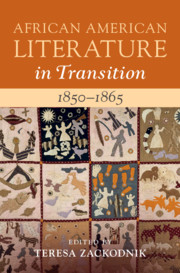Book contents
- African American Literature in Transition, 1850–1865
- African American Literature In Transition
- African American Literature in Transition, 1850–1865
- Copyright page
- Contents
- Figures
- Contributors
- Preface
- Chronology, 1850–1865
- Introduction
- Part I Black Personhood and Citizenship in Transition
- Chapter 1 Freedom’s Accounts
- Chapter 2 Conduct Discourse, Slave Narratives, and Black Male Self-Fashioning on the Eve of the Civil War
- Chapter 3 Picturing Black Authorship with and against Stowe’s Lens
- Chapter 4 African American Periodicals and the Transition to Visual Intercourse
- Part II Generic Transitions and Textual Circulation
- Part III Black Geographies in Transition
- Bibliography
- Index
Chapter 4 - African American Periodicals and the Transition to Visual Intercourse
from Part I - Black Personhood and Citizenship in Transition
Published online by Cambridge University Press: 07 April 2021
- African American Literature in Transition, 1850–1865
- African American Literature In Transition
- African American Literature in Transition, 1850–1865
- Copyright page
- Contents
- Figures
- Contributors
- Preface
- Chronology, 1850–1865
- Introduction
- Part I Black Personhood and Citizenship in Transition
- Chapter 1 Freedom’s Accounts
- Chapter 2 Conduct Discourse, Slave Narratives, and Black Male Self-Fashioning on the Eve of the Civil War
- Chapter 3 Picturing Black Authorship with and against Stowe’s Lens
- Chapter 4 African American Periodicals and the Transition to Visual Intercourse
- Part II Generic Transitions and Textual Circulation
- Part III Black Geographies in Transition
- Bibliography
- Index
Summary
The complex interaction between the visual and print culture is central to transitions in definitions and perceptions of Black personhood and mid-century African American literature. Marshaled by race science and criminology, and underwriting the emergence of the periodical as media form in the United States through its advertisements for fugitives and enslaved Africans for sale, visuality was imbricated with print. Autumn Womack approaches visuality in the Anglo-African Magazine through its statistical essays in order to contend that the magazine was brokering a transition from a text-based articulation of Black freedom to one figured in and through visuality. The “visual grammar” that resulted, she argues, presented Black freedom as accomplished and aspirational. Womack thus further elaborates the scholarly contention that Black American practitioners of visuality ranged beyond those using photography, such as Frederick Douglass and Sojourner Truth, to those debating the visual’s affordances in written texts, including Martin Delany, William J. Wilson, Ida B. Wells, Harriet Jacobs, Paul Laurence Dunbar, Louisa Picquet, W. E. B. Du Bois, and Booker T. Washington. She argues that the Anglo-African Magazine explored and reframed the conceptual and visual dimensions of Black freedom by pursuing what optic strategies and practices it both demanded and engendered.
Keywords
- Type
- Chapter
- Information
- African American Literature in Transition, 1850–1865 , pp. 91 - 118Publisher: Cambridge University PressPrint publication year: 2021

